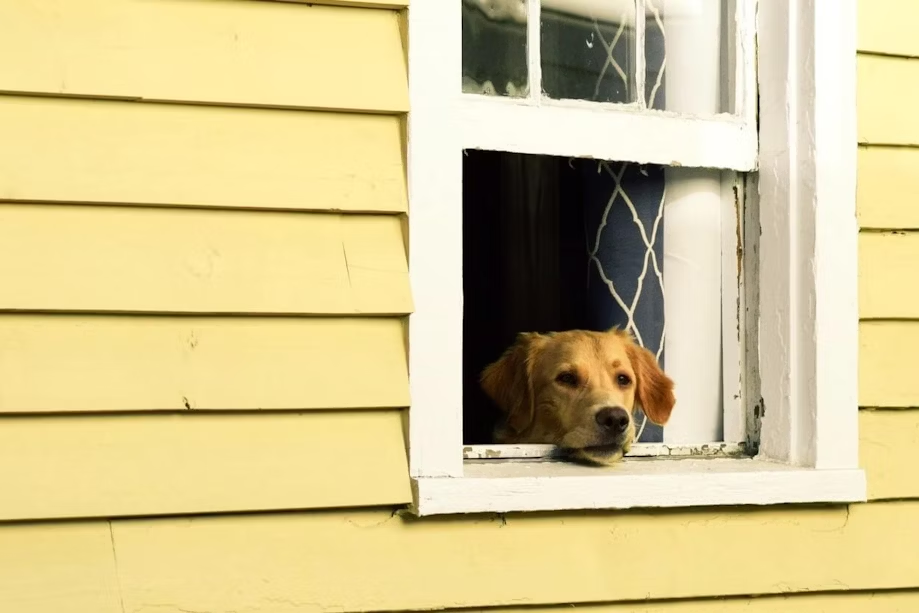With shelter-in-place mandates, unfamiliar work arrangements, and economic upheaval, COVID-19 has flipped life upside down for most of us. And it turns out, the impact isn’t limited to humans.
Social distancing is hard for dogs, too.
In fact, many pet owners have noticed their dogs displaying signs of unease and anxiety (or just acting plain weird) since quarantined. So, the pandemic may very well be stressing your dog out.
Why? Read on for an explanation, as well as possible solutions. (Because no one likes a sad pup.)

1. Social distancing disrupts routines (and diets).
Just like people, pets benefit from routine. Dogs, in particular, thrive when they know what to expect—and what’s expected of them.
But if you’re like us, social distancing has wreaked havoc on your habits. For one thing, you’re probably spending much more time at home. And though your dog surely loves the additional cuddle sessions, they may be a little thrown off by them.
Consider your dog’s perspective: Days used to be calm and quiet, with lots of naps scheduled in. But now people are around all day long, disturbing the peace with conference calls and other activities (and making it more tempting to play rather than sleep). Plus, your dog can sense how you feel—so, they’re probably picking up on your heightened levels of anxiety, too.
Outside of the home, habits have changed just as dramatically. For instance, dogs that often visited parks, attended daycare, or met for doggy dates no longer can. On the flip side, many pups that were homebodies before are now being ushered onto (multiple) daily walks by stir-crazy pet parents.
Social distancing may be impacting your dog’s diet, as well. After all, when sitting around at home all day, it’s harder to resist puppy dog eyes. (Translation: Dogs get more treats.) And if your dog’s activity levels have increased lately, their caloric needs probably have, too.
All this is to say that life likely looks a lot different for your dog these days, and that could be unsettling to them.
What can you do?
Fortunately, the antidote to this problem is straightforward: Make life more predictable by adding structure.
Before COVID-19, you probably had scheduled meals and activities for your dog. If social distancing has upset that schedule, take steps to re-establish it now so it’s easier when you do eventually go back to normal life. The last thing you’ll want is to stress about getting your dog ready for a life adjustment, too!
Adding structure will also help make your life more manageable now—especially if you’re working from home with your dog.

2. Pack animals may struggle with social isolation.
Like their wolf ancestors, modern dogs are pack animals. That means they yearn for social interaction. But after thousands of years of domestication, most dogs enjoy the company of people as much as that of other dogs.
So, though they might have fun romping around with other dogs, your pup doesn’t necessarily need canine friends to be socially fulfilled. They just need you.
This fact should come as a relief under current circumstances. Your dog probably isn’t too distressed by the recent ban on greeting others on your walks or at dog parks. They will notice, however, when you’re not paying attention to them.
What can you do?
Though you may be (understandably) distracted by what’s going on in the world right now, it’s more important than ever to set aside time to bond with your pup. Not only will your dog appreciate the attention—you’ll likely experience health benefits, as well.
To get you started, we’ve already compiled a list of quarantine-friendly games to play together. Playtime is still going to be incredibly important because bored, restless dogs often direct their energy into destructive activities, such as chewing baseboards and digging up flower beds.
Keep in mind that breeds (and even individual dogs of the same breed) vary in how much social interaction they enjoy. For example, Golden Retrievers, Boxers, and Pugs tend to love spending most of their time with their owners. But a Basenji, Greyhound, or Shiba Inu? These might enjoy more alone time.
Watch your dog’s body language and behavior to figure out the appropriate amount of social time for them.

3. Quarantine complicates puppy socialization.
Socialization (i.e., the process of introducing your puppy to various life experiences) plays a key role in determining the future confidence and behavior of a dog. But the COVID-19 crisis makes it a little tricky.
After all, how do you socialize a puppy while social distancing? Fortunately, it is possible. You just have to be clever about it.
What can you do?
Though you may not be able to take your puppy out to meet friends or get familiar with new locations, there’s actually a lot you can do to socialize them at home.
For example, you could:
- Have them walk on different surfaces
- Play a variety of recorded noises for them (e.g., fireworks, doorbells)
- Take them for rides in your car
- Carry them on neighborhood walks
- Let them see you in goofy hats, glasses, and other accessories
- Introduce them to a variety of objects, including umbrellas and balloons
- Play videos of other animals for them to watch
- Practice “routine care” by inspecting their paws, teeth, ears, and tail
Check out our puppy socialization checklist for more ideas and tips.
Remember to give your pup some alone time as well. You might be together constantly now, but that will likely change once life returns to normal. Spending time apart will help prevent dependencies and separation anxiety in your pup down the road. (And this is a good idea even if you’ve got a mature dog.)

Stay safe. Stay well.
Though these are trying times, we will get through this together. We hope these tips help make life while social distancing a little more bearable for both you and your dog.
Give your pup some extra love for us!










